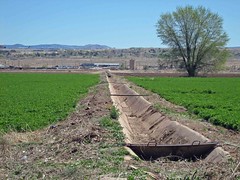I’m stretching the point a bit, but standing at the edge of an alfalfa field in Albuquerque’s South Valley this afternoon, I was reminded of Bruce Smith’s description in last Friday’s Science of the co-evolution of humans, dogs and the bottle gourd:
In Asia, for example, the domestication of two utilitarian species–the dog (for hunting) and the bottle gourd (for containers)–by ~12,000 years before the present (yr B.P.), did not so much involve deliberate human intervention as it did allow dogs and bottle gourds to colonize the human niche.
I’m abusing Smith’s point here, but I can’t help but marvel at the evolutionary success of the alfalfa plant. It started in Iran in the bronze age, and here it is, spread out over more than 4,000 acres of desert in the Middle Rio Grande Valley, making a good life for itself in this desert environment by exploiting our taste for milk and beef.
First, the alfalfa’s got to tame the river. The annual runoff can flood the whole valley floor, so the alfalfa got us to build levees and a big dam upstream to hold back the flood waters. Next, it needs a lot more water than nature provides. Up north of town, at a place called Angostura, the alfalfa got us to build a low dam to divert water out of the Rio Grande and into a spiderweb of irrigation ditches that envelopes the floor of Albuquerque’s central valley with the sort of beautiful ditch you see in the photo above.
The ditches are great for walking the dog, but we kid ourselves. The real reason the alfalfa had us build them is this. We have served our master well. 

